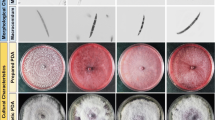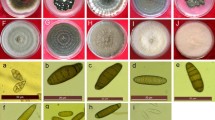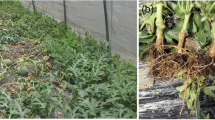Abstract
The fungal pathogen Fusarium sacchari causing wilt in sugarcane exhibits enormous variation in cultural characters. Detailed studies were conducted on recovery of the pathogen from wilt infected canes and to characterize the pathogen for its cultural characters. From 346 samples collected from 15 states, 263 Fusarium isolates were recovered and no other fungal genera were recovered. Overall, a higher pathogen recovery was recorded in nodal tissues as compared to internodal tissues of wilt infected stalk tissues. Cultural characterization of 117 isolates divided the Fusarium isolates into three groups based on radial growth as slow, moderate and fast. Based on mycelial colour, the isolates were grouped into seven groups viz., white, orange, pinkish orange, pink, dark pink, pinkish violet and reddish brown. The isolates were further divided into 21 groups based on mycelia colour on the top and agar pigmentation at the reverse side of the culture plate and three groups viz., submissive, raised and fluffy based on topology of the mycelium. Based on conidial frequency, the isolates were grouped as those produce microconidia with low, moderate, higher frequencies, micro and macroconidia at lower frequencies and micro and macroconidia production at higher frequencies. The results of this study revealed extensive variation in F. sacchari isolates recovered for their cultural characters from wilt infected stalks and sick soils.




Similar content being viewed by others
References
Agnihotri, V.P., and G.P. Rao. 2002. A century status of sugarcane wilt in India. In Sugarcane crop management, ed. S.B. Singh, G.P. Rao, and S. Eswaramoorthy, 145–160. Houston: SciTech Publishing LLC.
Booth, C. 1971. The genus Fusarium. Kew: Commonwealth Mycological Institute.
Bourne, B.A. 1953. Studies on dissemination of sugarcane diseases. The Sugar Journal 16: 19.
Burgess, L.W., C.M. Liddell, and B.A. Summerell. 1988. Laboratory manual for Fusarium research, 2nd ed. Sydney: University of Sydney.
Butler, E.J., and A.H. Khan. 1913. Some new sugarcane diseases. Part I, wilt, botany series, vol. 6, 180–190. India: Memoirs of Department of Agriculture.
Campbell, C.K., E.M. Johnson, C.M. Philpot, and D.W. Warnock. 1996. Identification of pathogenic fungi. London: PHLS.
Gams, W. 1971. Cephalosporium—artige Schimmelpize (Hyphomycetes), 262. Stuttgart: G Fischer.
Gerlach, W., and H. Nirenberg. 1982. The genus Fusarium—a pictorial atlas. Mitt Biol Bundesanstalt Land-U Forstwirtsch (Berling-Dahlem) 209: 1–406.
Kirtikar, G.P. Singh, and R. Shukla. 1972. Role of seed material in carryover of wilt disease of sugarcane. Indian Sugar 22: 89–90.
Leonian, L.H. 1929. Studies on the variability and dissociation in the genus Fusarium. Phytopathology 19: 753–868.
Leslie, J.F., and B.A. Summerell. 2006. The Fusarium laboratory manual. Oxford: Blackwell Publishing.
Nelson, P.E., T.A. Toussoun, and W.F.O. Marasas. 1983. Fusarium species: An illustrated manual for identification. University Park: Pennsylvania State University Press.
Nirenberg, H. 1976. Untersuchungen über die morphologische und biologische Differenzierung in der Fusarium-Sektion Liseola. Mitt Biol Bundesanstalt Land-U Forstw (Berling-Dahlem) 169: 117.
Poongothai, M. 2010. Cultural, morphological, molecular and pathogenic characterization of pathogen(s) causing sugarcane wilt in India. Ph.D. thesis, Bharathiar University, Coimbatore.
Seifert, K.A. 1996. FusKey-Fusarium interactive key. Agriculture and Agri-Food Canada.
Singh, K., R.P. Singh, and V.P. Agnihotri. 1975. Taxonomy and pathogenicity of fungi causing sugarcane wilt syndrome. Indian Phytopathology 28: 86–91.
Singh, K., and R.P. Singh. 1974. Involvement and pathogenicity of Acremonium in wilt syndrome of sugarcane. Sugarcane Pathologists Newsletter 11(12): 24–25.
Viswanathan, R. 2012. Sugarcane diseases and their management. Coimbatore: Sugarcane Breeding Institute.
Viswanathan, R., P. Malathi, A. Ramesh Sundar, M. Poongothai, and N. Singh. 2006. Current status of sugarcane wilt in India. Sugar Cane International 24(4): 1–7.
Viswanathan, R., M. Poongothai, and P. Malathi. 2011. Pathogenic and molecular confirmation of Fusarium sacchari causing wilt in sugarcane. Sugar Tech 13: 68–76.
Viswanathan, R., M. Poongothai, P. Malathi, and A. Ramesh Sundar. 2012. Sugarcane wilt: New insights into the pathogen identity, variability and pathogenicity. In Functional plant science and biotechnology (special issue 2), vol. 6, ed. R. Viswanathan, and A.R. Sundar, 30–39. Ikenobe: Global Science Books.
Viswanathan, R., and G.P. Rao. 2011. Disease scenario and management of major sugarcane diseases in India. Sugar Tech 13: 336–353.
Wineland, G.O. 1924. An ascigerous stage and synonomy for Fusarium moniliforme. Journal of Agricultural Research 28: 909–922.
Acknowledgments
The authors thank Dr. N. V. Nair, Director of the Institute for providing the facilities and encouragement. The help rendered by different the sugar factory authorities for conducting disease survey and collection of samples is gratefully acknowledged. The work was supported by Network Project from ICAR, New Delhi.
Author information
Authors and Affiliations
Corresponding author
Electronic supplementary material
Below is the link to the electronic supplementary material.
Rights and permissions
About this article
Cite this article
Poongothai, M., Viswanathan, R., Malathi, P. et al. Sugarcane Wilt: Pathogen Recovery from Different Tissues and Variation in Cultural Characters. Sugar Tech 16, 50–66 (2014). https://doi.org/10.1007/s12355-013-0249-2
Received:
Accepted:
Published:
Issue Date:
DOI: https://doi.org/10.1007/s12355-013-0249-2




